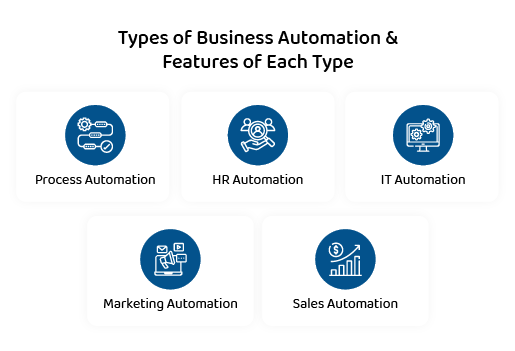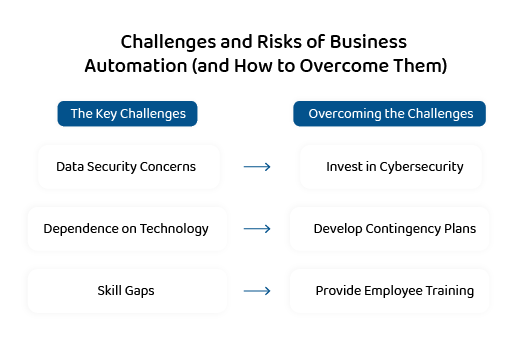Highlights of the Blog
-
Explanation of the concept, benefits, and challenges to grasp how automation simplifies processes while addressing potential limitations like implementation costs and complexity
-
Explore various types and their unique features to identify solutions tailored to specific business needs and operational goals
-
Learn which industries benefit the most from automation, such as manufacturing, healthcare, and retail, where efficiency and accuracy are critical
Business Automation has emerged as a critical driver of efficiency and innovation. By leveraging technology to handle repetitive tasks, organizations can redirect their focus toward strategic goals.
This guide dives deep into the concept of Business Automation, exploring its benefits, challenges, types, and industry-specific impacts, while linking to key subtopics for a comprehensive understanding.
What is Business Automation?
Business Automation refers to the process of using technology to perform tasks that were traditionally done manually. From automating simple tasks like email responses to complex processes like supply chain management, automation has transformed the way businesses operate.
Automation can significantly speed up processes. For example, 74% of employees using automation report that it helps them work faster. By reducing manual intervention, automation not only enhances efficiency but also minimizes human errors, allowing businesses to focus on strategic goals rather than repetitive tasks.
Key Benefits of Business Automation:
- High Efficiency: Automation reduces the time taken to complete repetitive tasks, allowing businesses to operate more efficiently. In fact, nearly 50% of work activities could be automated using current technology, significantly boosting productivity.
- Lesser Costs: By automating routine tasks, companies can cut labor costs and reduce errors that may lead to financial losses.
- Maintain accuracy: Automated processes minimize human error, ensuring higher accuracy in operations.
Common Challenges:
Despite its benefits, implementing Business Automation is not without challenges. Companies often struggle with:
- High Initial Costs: The set-up and implementation of automation tools can require significant investment. The initial investment for industrial automation can be significant, often deterring smaller firms. However, the return on investment (ROI) can be expected within 2-3 years.
- Employee Resistance: Workers may feel threatened by automation, fearing job loss.
- Integration Issues: Ensuring that new automation systems work seamlessly with existing tools can be difficult.
For a deeper dive into the benefits and challenges of business automation, explore our detailed blog here.
Types of Business Automation & Features of Each Type

Business Automation spans a variety of applications, each tailored to different needs and industries. Key types include:
- Process Automation: Focuses on streamlining workflows and reducing manual intervention. Common tools include workflow management software and robotic process automation (RPA). In fact, 48% of organizations are currently installing automation solutions to automate manual tasks, highlighting the growing emphasis on efficiency and productivity in modern business operations.
- Marketing Automation: Automates marketing tasks like email campaigns, lead generation, and social media posting to enhance customer engagement.
- Sales Automation: Simplifies the sales process by automating lead tracking, follow-ups, and performance analysis.
- HR Automation: Handles tasks such as recruitment, payroll processing, and employee onboarding.
- IT Automation: Automates routine IT tasks like software updates, monitoring, and backups.
Each type of Business Automation comes with unique features designed to address specific challenges. For an in-depth view of these types, here’s our blog.
Industries That Benefit the Most from Business Automation
Certain industries are particularly well-suited to harness the power of Business Automation:
- Retail: Inventory management and supply chain processes are streamlined through automation, ensuring timely stock replenishment.
- Healthcare: Automating medical record-keeping and appointment scheduling enhances patient care.
- Manufacturing: Robotics and automation tools boost productivity and minimize errors in production lines.
- Finance: Automating fraud detection, compliance monitoring, and financial reporting increases efficiency and reduces risks.
To explore how different sectors are leveraging automation, here is our thorough analysis.
Challenges and Risks of Business Automation (and How to Overcome Them)

While Business Automation offers transformative benefits, it also comes with inherent risks.
The Key challenges include:
- Data Security Concerns: Automated systems often handle sensitive data, making them potential targets for cyberattacks.
- Dependence on Technology: Over-reliance on automation can be risky if systems fail or encounter technical glitches.
- Skill Gaps: Employees may need upskilling to manage and interact with automated tools effectively.
Overcoming These Challenges:
- Invest in Cybersecurity: Secure your automated systems with robust cybersecurity measures.
- Develop Contingency Plans: Have backup systems in place to handle potential failures.
- Provide Employee Training: Equip your workforce with the skills needed to work alongside automation.
For strategies to mitigate these challenges, check out our complete blog on it.
Conclusion
Business Automation is revolutionizing industries by boosting efficiency, reducing costs, and enhancing accuracy. However, successful implementation requires careful planning and consideration of challenges.
By understanding the types of automation, their features, and their industry-specific applications, businesses can unlock their full potential.
Also, if you are looking to automate your business, check out CBSL’s Business Automation solutions today to stay ahead in this transformative era.
Frequently Asked Questions
1. What is meant by business automation?
Business automation refers to the use of technology and digital solutions to streamline processes, reduce manual work, and improve efficiency. CBSL Group specializes in automation solutions for businesses, particularly in banking, document management, and customer service, to optimize workflows and enhance operational productivity.
2. What does automation do to a business?
Automation in business leads to:
- Increased efficiency: Automates repetitive tasks, reducing human effort
- Cost savings: Lowers operational costs by reducing manual labor
- Error reduction: Ensures accuracy and consistency in processes
- Improved customer experience: Provides faster and more reliable services, such as automated banking kiosks
- Data-driven decision-making: Enables businesses to access real-time insights for better strategy planning
3. What is an automated business?
An automated business uses technology to handle core functions with minimal human intervention. For example, CBSL Group provides automated banking kiosks for tasks like cheque deposits, passbook printing, and customer onboarding. These kiosks enhance self-service banking, reducing dependency on manual processing.
4. How to automate your business example?
One way to automate a business is by implementing a Queue Management System (QMS). CBSL Group's QMS helps manage customer queues in real time, directing customers efficiently and reducing wait times in bank branches. This improves customer satisfaction and optimizes staff productivity.